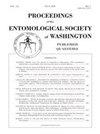标题大南瓜果蝇双翅目:双翅目:绢蝇科)未成熟阶段的描述
IF 0.4
4区 农林科学
Q4 ENTOMOLOGY
Proceedings of the Entomological Society of Washington
Pub Date : 2022-12-08
DOI:10.4289/0013-8797.124.3.661
引用次数: 0
摘要
摘要本文利用光学显微镜和扫描电子显微镜对毕氏大哥大(Dacus bivittatus Bigot)的卵、三龄期和蛹进行了描述,并与其他已描述过这些阶段的大哥大(Dacus Fabricius)物种以及侵染葫芦的两种重要害虫(Zeugodacus Hendel)进行了比较。一个新的解剖学术语,侧唇,介绍了一个特征的面部面具。这里描述了以前没有报道过的绦虫科卵的一个特征:在靠近后端部分环绕卵的不规则线上有一种特殊的气柱体排列。光镜下的形态特征表提供了诊断信息,可以将双vittatus Dacus的幼虫与大多数其他Dacus物种和两种已描述过幼虫的Zeugodacus物种区分开来。本文章由计算机程序翻译,如有差异,请以英文原文为准。
Description of the Immature Stages of Dacus bivittatus (Diptera: Tephritidae), the Greater Pumpkin Fruit Fly
Abstract. We describe the egg, three instars, and pupa of Dacus bivittatus Bigot using optical and scanning electron microscopy and compare them with those of other Dacus Fabricius species for which these stages have been described as well as those of two important pest species of Zeugodacus Hendel that infest cucurbits. A new anatomical term, lateral lips, is introduced to describe a feature of the facial mask. A feature of the egg that has not been reported previously for Tephritidae is described here: a peculiar arrangement of aeropyles in an irregular line partially encircling the egg near the posterior end. A table of morphological characters visible with light microscopes provides diagnostic information to separate larvae of Dacus bivittatus from those of most other Dacus species and two Zeugodacus species for which larvae have been described.
求助全文
通过发布文献求助,成功后即可免费获取论文全文。
去求助
来源期刊
CiteScore
0.90
自引率
16.70%
发文量
40
审稿时长
>12 weeks
期刊介绍:
The Proceedings of the Entomological Society of Washington is published four times a year in January, April, July, and October. The journal publishes on all aspects of original research in entomology. Subject matter includes systematics, taxonomy, biology, behavior, ecology, morphology, genetics, and other topics.

 求助内容:
求助内容: 应助结果提醒方式:
应助结果提醒方式:


